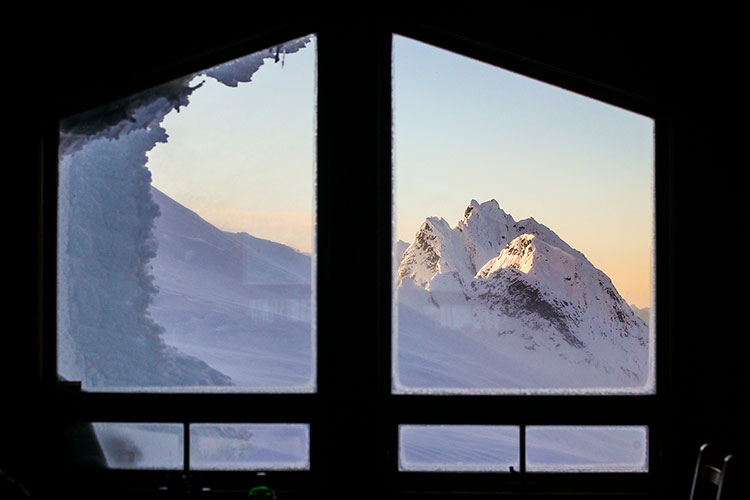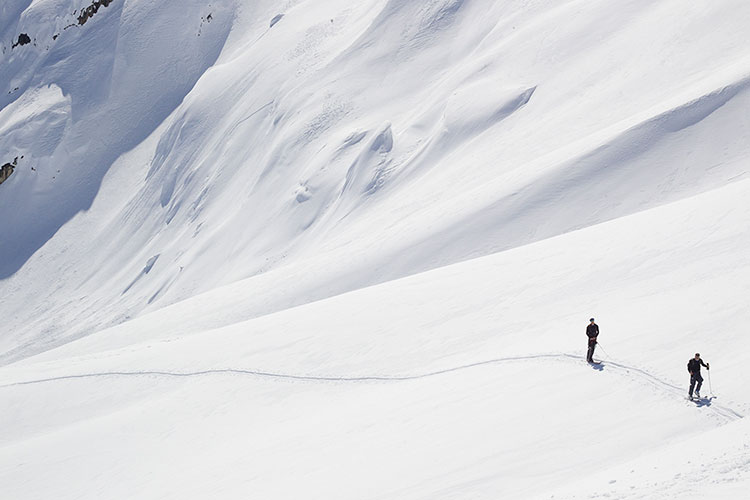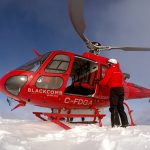It’s no secret that backcountry hut culture is on the rise. These iconic mountain structures can be found in our backyard ready for respectful adventurers.
There is something magical about spending the night in one of these unique mountainside accommodations. Backcountry huts provide an atmosphere where you can properly embrace the calm, tranquility of the mountains over tea, cozied up with friends and far away from “real world” worries.

These public huts made by clubs and organizations are designed to be enjoyed and to keep inspiring the next generation of mountain lovers. That’s why we want to make sure these treasured places are respected and cared for to keep hut culture thriving.

Backcountry Hut Etiquette
So you’ve selected a hut, you’ve done your research, your bags are packed, but there’s something more we need to tell you. It’s called hut etiquette.
These places are fundamentally important to our mountain culture and preserving them for future use is the responsibility of anyone who is lucky enough to experience them. Each hut will have its own systems for water, waste, cleaning, maintenance, do’s and don’ts — brush up on these before your departure and check out any signage in the hut that may indicate additional protocols. There are, however, a few universal things that will make the hut happy and those sharing it with you happy too.
Yes, please do this:
- Pack it out. And by it we mean everything. Also, pack out garbage that might have been left behind by someone else.
- Close the door tight every single time. This stops rodents (see food point below) from getting in and keeps the doors from icing up in the winter months.
- Read up on the individual huts online before visiting. There might be crucial information as to water systems, waste management and hut expectations. This will also help you gauge what to pack — do you need a sleeping mat or is there foam in the loft etc.
- Be conscious of keeping the fresh water source around the hut fresh. This means any kind of waste including grey water should be drained below the hut and away from where you collect your fresh water.
- Sweep. Gear, shoes and humans are messy, just keep sweeping.
- Ask before playing music. Most people are down with some chill tunes but a courtesy ask is very important.
- Bring extra toilet paper. It’s a great fire starter and a welcome gift to leave behind if you have extra.
Nope, don’t do that:
- Do not leave your food out. At all. Not even a crumb. In these remote locations there are rodents of various sizes and they all love food. It’s devastating to have one person forget to properly manage their food and have rodents keep you up all night long. Some huts have sealable bins to protect the food, others will require you to hang your food in a sealed bag from the rafters. Look into the hut before you go. Please note, the same goes for garbage.
- Don’t be the king / queen of the drying rack. Rotate your items so that everyone has a turn to properly dry out their gear.
- Don’t start a fire in the middle of the day. Firewood is reserved for overnight heat in the cold.
- Don’t stay up too late or be too loud. Huts are for bringing you closer to the mountains, most people will have objectives that require early start times and they really value their sleep. If your intention is to stay up late and be noisy with pals, please make sure you book the entire hut.
- Don’t wear wet shoes in the hut, no one likes wet socks or hut booties.
- Don’t forget to sign the guest book!
Whistler Backcountry Huts
This blog post is not intended to be a trip report, but rather a place to draw inspiration from and bring awareness to potential hut expeditions in the Whistler region. Each of these huts can be reserved online prior to your visit, and for some, you might need to become a member. But, please note that you’ll need maps, proper backcountry experience and navigation skills to get you there. Take a look at this blog post for some more tips and information on getting ready for your backcountry adventure: Exploring Whistler’s Iconic Backcountry Peaks in Winter.

Brew Hut: Varsity Outdoor Club (VOC)
Just south of Whistler lies Mount Brew. Cradled near the peak is a hut that sleeps up to 12 people, has a wood stove with a limited amount of wood, Coleman cooktop, and an outhouse. After a steep (over 800 metres) hike or ski tour of 5 – 7 kilometres one way, the cozy digs will be a welcome sight. This hut is a rarity as it doesn’t have a formal booking system, but there is an online registration board to gauge activity level, capacity and closures for trip planning.
Brew Hut has a particularly interesting history. Due to frequent avalanche activity and massive snowfall amounts in the area, this isn’t the first hut on Mount Brew. After a few failed attempts, the hut at its current location has been around since 2005.
Burton Hut: Varsity Outdoor Club (VOC)
Known officially as the Roland Burton Hut, named after its original builder, it is also often referred to as the Sphinx Hut. It sleeps 10, has an outhouse, a gas stove and two burners for cooking, but I recommend bringing your own cooking stove. This backcountry shelter is one of the oldest in our region. Its build is pretty true to its 1969 form, but it has seen upgrades over the years. It is not used as frequently as other surrounding huts due to its hard to reach location on the east side of Garibaldi Lake.
There is no trail to reach this hut in the summer, although a creative mind with a strong back could bring an inflatable paddle board or packraft to make the crossing. This hut is used more in the winter when Garibaldi Lake is frozen and can be crossed on skis. Its elusive location makes it all the more rewarding when you reach it and it opens up terrain unseen by many. Because of its remoteness, as per any hut, make sure you do your due diligence prior to any visit by researching on the VOC website, paying your booking fees and getting a wilderness camping permit for Garibaldi Park.

Wendy Thompson Hut: Alpine Club of Canada (ACC)
Located in the Marriott Basin north of Whistler, this hut is technically in Pemberton, as access is off of the Duffey Lake Road, but it is maintained by the Whistler section of the ACC. It sleeps 16, has sleeping foam in the loft, a wood stove, outhouse, and a large area for food prep and eating, but no cooking stove, so you need to bring your own.
After a 2 to 3-hour hike or ski tour you’ll reach the pristine hut. Upon spotting the picturesque Gothic-arched structure you’ll be overwhelmed with ski touring potential.
Spearhead Huts: Alpine Club of Canada (ACC)
The Spearhead Huts project will see the creation of three incredible huts in the Whistler backcountry along the Spearhead Traverse. The first is the Kees and Claire Memorial Hut, which is already up and running. This hut offers 38 bunks across six sleeping areas, and is located above Russet Lake.
The next hut will be the MacBeth Hut approximately halfway along the Spearhead Traverse, and the final construction will be the Pattison Hut.
Once complete, we’ll have a three-hut ski touring route accessible from the top of Whistler Blackcomb. Providing a nice, sheltered break along the classic Spearhead Traverse, this is a welcome addition to the ACC Whistler family.
Other Huts Near Whistler
Pemberton: Harrison Hut (VOC), North Creek Cabin (British Columbia Mountaineering Club: BCMC), and Brian Waddington Hut (VOC).
Squamish: Watersprite Lake Hut (BCMC), Jim Harbel Hut (ACC), and Tantalus Hut (ACC).
Vancouver: Mountain Lake Hut (BCMC).
If this has inspired you to go on your own backcountry hut adventure, let the team at Whistler.com help you with a base camp in Whistler. March is historically a snowy month in the mountains so, with longer days and great conditions, spring is a great time to explore.


